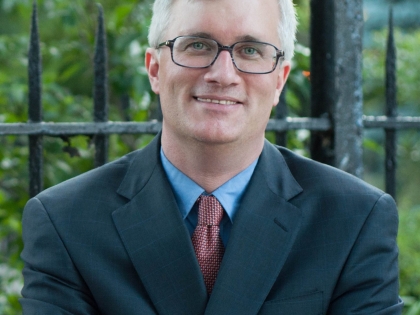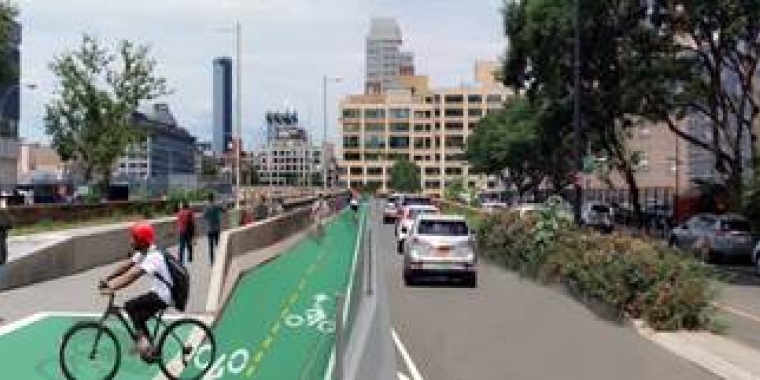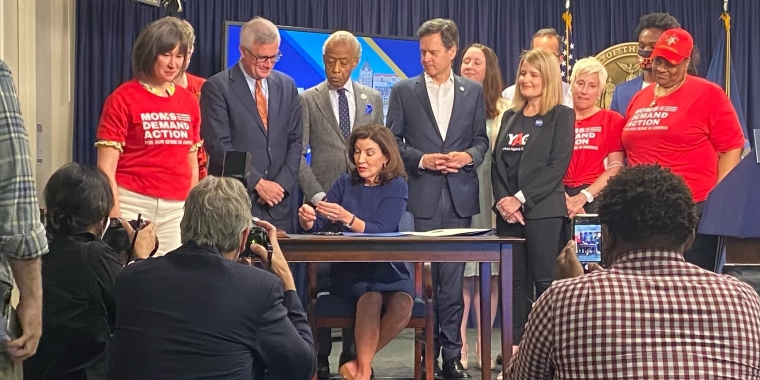
Forwarding: Mayor Announces Construction of Brooklyn Bridge Protected Bike Lanes Begins Next Week
June 17, 2021

OFFICE OF THE MAYOR
FOR IMMEDIATE RELEASE: June 17, 2021
CONTACT: pressoffice@cityhall.nyc.gov, (212) 788-2958
Bridges for the People: Mayor de Blasio Announces Construction of Brooklyn Bridge Protected Bike Lanes Begins Next Week
Starting at 9pm on Monday, June 21st, motorists are advised of major changes reaching the bridge; the addition of protected bike lanes will relieve longtime congestion on the Brooklyn Bridge promenade—the first reconfiguration of the iconic bridge since trolley tracks were permanently removed in 1950
NEW YORK—Mayor Bill de Blasio today announced that, starting next Monday, the New York City Department of Transportation (DOT) will implement major bicycle and pedestrian accessibility improvements on the Brooklyn Bridge. As part of the project, the innermost Manhattan-bound vehicular lane on the Brooklyn Bridge will be removed and transformed into a two-way protected bike lane. Promised in the Mayor’s State of the City address in January to address the surge in cycling during the pandemic, the addition of protected bike lanes this year will be the first major reconfiguration of the landmarked bridge since 1950, when trolley tracks were permanently removed.
Motorists who normally access the Brooklyn Bridge from downtown Brooklyn are advised that they may have to adjust their commuting patterns both during and after construction. Beginning Monday evening, the right turn from westbound Tillary Street onto the Brooklyn Bridge will no longer be permitted. Combined with delays expected for the planned rehabilitation in the months ahead along the triple-cantilever section of the BQE, drivers are advised to seek alternate routes to Lower Manhattan, including using the Manhattan Bridge, the Hugh L. Carey Tunnel or by opting for cycling or mass transit. Construction of the new two-way protected bike path is expected to be completed by early fall.
“Bridges for the People is a beautiful reimagining of New York City’s most iconic bridge,” said Mayor de Blasio. “Before the Brooklyn Bridge was last reconfigured in 1950, it carried 400,000 New Yorkers every day—but completely replacing trolleys with car lanes reduced the number of daily bridge users by more than half. By adding new protected bike lanes on the bridge, we will finally begin to re-balance that equation, supporting more sustainable transportation for decades to come.”
“As more New Yorkers take up biking, safe bike lanes have become even more critical to our city’s recovery” said Deputy Mayor for Operations Laura Anglin. “Adding a bike lane to the iconic Brooklyn Bridge will help ease bike traffic for tourists and commuters alike, while increasing safety for everyone.”
“The Brooklyn Bridge, one of the nation’s most beloved structures, will this year celebrate its 138th birthday,” said DOT Commissioner Hank Gutman. “Over that long history, the bridge has changed with the times – as horse-drawn carriages were replaced with trolleys, which were then retired with the advent of car lanes. In the coming months, we are going to transform this bridge we all love once again – this time with new bicycle lanes that invest in the bridge’s more sustainable future. We ask New Yorkers for their patience during construction, and encourage drivers to use other crossings into Manhattan. And of course, we look forward to the first bike ride this fall.”
The Brooklyn Bridge protected bike lane project was initially announced in January as part of the State of the City address, and builds on Mayor de Blasio's ambitious commitment to install a record 30 miles of protected bike lanes citywide in 2021. The creation of protected bike lanes on the roadway not only offers a safer and more seamless route along the bridge for cyclists, it will expand the dedicated space on the bridge’s promenade for pedestrians, who have numbered more than 10,000 on some days in recent years.
During construction, vehicular access to the bridge from downtown Brooklyn via Adams Street and Sands Street will still be permitted, and the promenade will remain open to pedestrians and cyclists. “No Turning” signs will be installed to remind motorists of the roadway changes. Diversions are expected to move traffic in Downtown Brooklyn to both bridges along Gold Street, Nassau Street and the Flatbush Avenue Extension.
“I'm thrilled that the Brooklyn Bridge is finally getting a proper bike lane," said City Council Speaker Corey Johnson. ”With more and more pedestrians and cyclists on our streets, we need to constantly reexamine what it means to get around this city to make it more accessible for everyone. The Council’s design competition for the Brooklyn Bridge encouraged New Yorkers to reimagine not just the design of this bridge, but its vast potential to support more forms for sustainable modes of transportation and it's exciting to see the City finally take some steps to make more room for cyclists on the bridge which was so desperately needed."
“Finally New Yorkers can rejoice as a major choke point in our cycling network is relieved,” said Manhattan Borough President Gale A. Brewer. “This project will not only increase cyclist safety and increase ridership but it will improve pedestrian safety and congestion on the Brooklyn Bridge Promenade. I look forward to additional bike projects this year including the crucial connections to Lafayette and Centre Streets on the Manhattan side of the bridge.”
“The Brooklyn Bridge isn’t just one of New York City’s most vaunted historic sites; it’s also a main thoroughfare for thousands of New Yorkers, who rely upon it for their commutes to work and to travel from borough to borough. Yet for the increasing numbers of New Yorkers who rely on bicycles to get around our city, the Brooklyn Bridge—which has long prioritized motorized travel—can often feel inhospitable and dangerous,” said Congress Member Jerrold Nadler. “We must do more to protect New York’s cyclists, which is why I’m delighted by the NYC Department of Transportation’s announcement that it will construct a two-way protected bike lane on the Brooklyn Bridge, rendering one of our city’s crown jewels safer and more inclusive for cyclists, pedestrians, and residents alike.”
“A lot of New Yorkers use the Brooklyn Bridge every day to commute to work, and when the pandemic started that number grew, with many taking up cycling as a way to get exercise and be outside while maintaining social distancing guidelines,” said Congresswoman Velazquez. “With the surge in cyclists in the city, it is vital that we offer additional protected bike lanes for safety. This reconfiguration of the Brooklyn Bridge will hopefully be the first of many projects of its kind to offer more accessibility, help to accommodate the increase in cyclists across the bridge and allow freer, less encumbered use of the world-class Brooklyn Bridge promenade by pedestrians.”
“Since it opened more than 138 years ago, the Brooklyn Bridge has been both an essential transportation route for New Yorkers and an icon of our city for visitors from around the world. As New Yorkers increasingly take up bicycles as a healthy and environmentally friendly way to travel, it is fitting that we update the Brooklyn Bridge to dedicate space for a safe, efficient bikeway,” said State Senator Brian Kavanagh, who represents lower Manhattan and western Brooklyn on both sides of the Bridge. “I commend Mayor de Blasio, Commissioner Gutman, and the Department of Transportation for their efforts to expand bicycle and pedestrian accessibility throughout our city and help people share these spaces safely.”
“Adding protected bike lanes to the iconic, magnificent Brooklyn Bridge will help us keep pedestrians, bikers, and motorists safer,” said Assembly Member Jo Anne Simon. “As biking for commuting as well as pleasure continues to rise in New York City, safety is paramount. The benefit of reducing traffic congestion and emissions is a plus for the City’s residents and visitors also. I look forward to a safer, more functional, and still beautiful Brooklyn Bridge connecting the two boroughs.”
“During my time at the Council as Chairman of the Transportation Committee I have been working closely with my colleagues at the Council and the administration to make New York City the most cyclist, pedestrian, and accessible City in the Nation. We must continue expanding on initiatives that increase bike and pedestrian paths across the 5 boroughs,” said Council Member Ydanis Rodriguez, Chairman of the Transportation Committee. “The Brooklyn Bridge is used daily by thousands of New Yorkers and tourists traveling to and from Manhattan. This initiative will keep both pedestrians and cyclists safer by installing a two-way protected bike path for cyclists while expanding the bridge’s promenade for pedestrians. I look forward to continuing to work alongside Mayor de Blasio, DOT Commissioner Hank Gutman, my colleagues at the Council, and advocates as we continue making our streets safer for all pedestrians and cyclists.”
“Brooklyn Bridge is such a popular destination for tourists and New Yorkers alike, and it’s so important that we design our pathways in a way that keeps everyone safe,” said Council Member Margaret Chin. “I’m so happy to see construction of these exciting improvements move forward. The installation of a protected bicycle lane and expansion of the pedestrian walkway will greatly improve the experience of crossing over the bridge for everyone.”
“Wide protected bike lanes on the Brooklyn Bridge have been needed for years,” said Council Member Brad Lander. “As we move to more alternative modes of transit from cars we have to provide the proper infrastructure. These lanes will relieve crowding on the bridge and will make the Bridge safer and more accessible for pedestrians and bikers.”
"Bike traffic over the East River bridges is booming. The latest figures show a 27 percent increase over pre-pandemic ridership. A dedicated bike lane on the Brooklyn Bridge cannot come soon enough, and we are thrilled that construction is beginning this month. We will continue to work with the de Blasio administration and the next occupant of City Hall to improve infrastructure for cyclists and pedestrians on bridges across the five boroughs," said Executive Director of Transportation Alternatives Danny Harris.
“Bike lanes save lives,” said President and CEO, Regional Plan Association Tom Wright. “Creating a safe space for bicyclists on the Brooklyn Bridge - one of the most popular destinations in New York City - is the right thing to do for our health, our safety and our communities at large. We’re elated to see one of the recommendations from our Five Borough Bikeway report become reality, and we look forward to more robust network throughout our five boroughs.”
“This is a major milestone on so many levels,” said Policy & Communications Manager for Tri-State Transportation Campaign Liam Blank. “Clawing back space from cars on one of the most famous bridges in the country is a huge improvement, and we commend Mayor de Blasio and NYC DOT for working hard to finally restore balance to the City's transportation network. It's critical that the City continues building safe infrastructure for micro-mobility users as we encourage more people to ditch their cars. We're eager to see the results of the bridge's transformation once the project is complete and we look forward to working with DOT Commissioner Gutman on the next several miles of new protected bike lanes.”
"Expanding protected bike lanes encourages more New Yorkers to bike, and when more New Yorkers bike, we improve our air quality. Fewer cars on the road will lead to fewer emissions from transportation - the state's #1 contributor to climate change. That's why clean transportation is one of NYLCV's top priorities. The Brooklyn Bridge bike lane will reduce congestion and increase access to open space by expanding the dedicated area on the promenade for pedestrians. We are excited that the City is starting construction on this important project and we thank Mayor de Blasio and Commissioner Gutman for moving it forward,” said President of the New York League of Conservation Voters Julie Tighe.
“When you put a bicycle lane on a road that runs through an iconic landmark like the Brooklyn Bridge it says many things: our city’s commitment to shift away from designing roadways and public spaces around the single car centric modality New Yorkers have endured for a century. It shows our commuters that a light, slow moving, vehicle such as a bicycle has the same value as a heavy, fast moving, combustion engine powered vehicle does. It tells those people who choose to travel by bicycle or by foot that the city has our back, and our government is committed to improve conditions for road users who opt to travel by modalities that are more affordable, reliable, accessible, and better for the health of our city. This installment of a new dedicated bicycle lane across the Brooklyn Bridge sets a new precedence for our city. It is the kind of precedent other national cities will look to as they continue to reconfigure their roadways and it is one New Yorkers can be proud of,” said Get Women Cycling, Founder and Executive Director Angela Azzolino.
About the Brooklyn Bridge
The Brooklyn Bridge, completed in 1883, is both a National and New York City Historic Landmark. Maintenance and upkeep of the bridge is the responsibility of DOT’s Division of Bridges, which is responsible for the operation and maintenance of 789 bridges and tunnels throughout New York City, including 24 moveable bridges, five tunnels and the iconic East River Bridges.
###
Share this Article or Press Release
Newsroom
Go to Newsroom